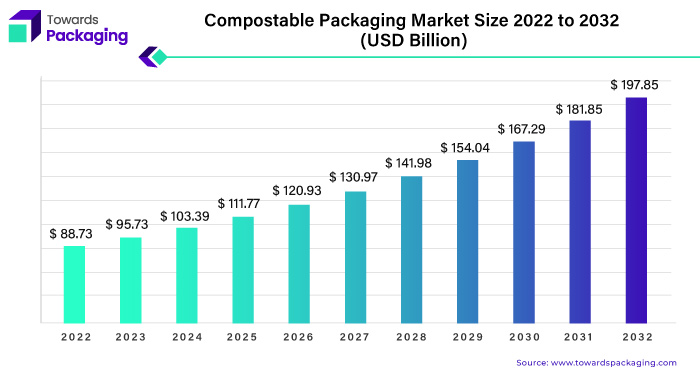The compostable packaging market has witnessed significant growth in recent years, driven by increasing consumer awareness regarding environmental sustainability and stringent regulations promoting eco-friendly practices. As of 2022, the market was valued at USD 88.73 billion, with projections soaring to USD 197.85 billion by 2032, indicating a robust CAGR of 8.4% between 2023 and 2032. In this comprehensive analysis, we delve into the factors fueling this exponential growth and the key trends shaping the future landscape of compostable packaging.
Environmental Imperatives Driving Market Growth
Consumer Demand for Sustainable Solutions
Consumer preferences have undergone a paradigm shift towards sustainable products, with a heightened focus on reducing carbon footprint and minimizing environmental impact. Compostable packaging aligns seamlessly with these aspirations, offering an eco-friendly alternative to traditional plastic packaging. The increasing awareness regarding plastic pollution and its detrimental effects on ecosystems has propelled consumers to actively seek products packaged in compostable materials.
Regulatory Initiatives Promoting Eco-Friendly Practices
Governments worldwide have instituted stringent regulations to curb plastic waste and promote the adoption of sustainable packaging solutions. Measures such as bans on single-use plastics, levying of plastic taxes, and incentivizing compostable packaging have created a conducive environment for market growth. These regulatory frameworks not only compel businesses to adopt eco-friendly practices but also foster innovation in compostable packaging technologies.
For an engaging revelation of this report – https://www.towardspackaging.com/personalized-scope/5121
Technological Advancements Driving Innovation
Biodegradable Materials and Advanced Manufacturing Processes
Technological advancements have revolutionized the landscape of compostable packaging, enabling the development of biodegradable materials with properties comparable to traditional plastics. Innovations in biopolymers, such as PLA (Polylactic Acid) and PHA (Polyhydroxyalkanoates), have expanded the scope of compostable packaging across various industries, including food and beverage, healthcare, and consumer goods. Furthermore, advancements in manufacturing processes have enhanced the efficiency and scalability of producing compostable packaging, making it more accessible to businesses of all sizes.
Functional Attributes and Customization Capabilities
Modern compostable packaging offers a myriad of functional attributes, ranging from barrier properties to heat resistance, ensuring product integrity and shelf-life extension. Moreover, advancements in printing technologies enable intricate designs and customization options, allowing brands to enhance their brand identity and engage consumers effectively. The versatility of compostable materials enables the creation of packaging solutions tailored to specific product requirements, driving adoption across diverse sectors.
Make a smart decision – acquire our study for valuable information: https://www.towardspackaging.com/price/5121
Scrutinize More:




Leave a Reply